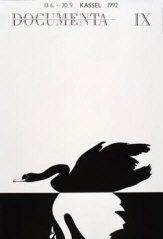Documenta 9
13 Jun - 20 Sep 1992
13 June - 20 September 1992
Kassel
Jan Hoet, artistic director of documenta 9 in 1992, described the exhibition as “a documenta of locations” and one based “solely on the artist and his work”. In not pursuing a theoretical concept with documenta 9, or offering a general thematic context, Hoet effectively broke with a documenta principle that had decisively shaped the exhibition's character at least since d5. Instead, Hoet saw the essential task of contemporary art to be to provide real subjective experiences in order to counter a reality that increasingly slipped into the virtual realm. The video installation “Anthro/Sozio” (1992) by Bruce Nauman can be considered a paramount example of this phenomenon. Displayed in the entrance hall of the Fridericianum, it took as its topic the physical threat to the subject. Equally, the outside installation “Toilet” (1992) could be interpreted in this manner, for Russian artist Ilya Kabakov had a public Russian toilet reproduced, and made recognizable as an apartment by positioning used furniture and personal belongings within it.. Hoet adopted an emotional approach, and the exhibition was experience-oriented, though he made no attempt to impose a systematic structure on the diversity of the contemporary art scene it or to evaluate it according to current norms. Simultaneously, Hoet succeeded in gaining a large number of additional exhibition spaces which had not previously been occupied by documenta, and extended the exhibition's active radius to seven buildings and countless locations in the public domain. Alongside the classic locations of Fridericianum and Orangerie, new exhibition venues included: the Neue Galerie (New Gallery); the staircase of the AOK health insurance company, and the Ottoneum (housing a natural-history museum), temporary buildings in the Karlsaue Park and the newly erected documenta hall behind the theatre, designed by architects Jochem Jourdan and Bernhard Müller. The character of the art displayed in these locations was in part adapted to the peculiarities of the setting. The works in the New Gallery, for example, were installed as commentaries on the existing permanent collection. Alternately, the principle of 'displacement' was applied, under which objects were showcased in alien contexts such as the natural history collections of the Ottoneum.
The accompanying program of d9 included jazz, as well as boxing and baseball. This extension of the presentation concept was understood as a central metaphor for art and life, and was responsible in no small way for the enormous popularity of d9. For the first time in the history of the documenta more than half a million people traveled to Kassel.
Artistic Director:
Jan Hoet
Artists:
Marina Abramović, Absalon, Richard Artschwager, Francis Bacon, Marco Bagnoli, Nicos Baikas, Mirosław Bałka, Matthew Barney, Jerry Barr, Lothar Baumgarten, Jean-Pierre Bertrand, Joseph Beuys, Michael Biberstein, Guillaume Bijl, Dara Birnbaum, Jonathan Borofsky, Louise Bourgeois, Herbert Brandl, Ricardo Brey, Tony Brown, Marie José Burki, Jean-Marc Bustamante, Michael Buthe, Pedro Cabrita Reis, Waltércio Caldas, Pier Paolo Calzolari, Ernst Caramelle, Lawrence Carroll, Saint Clair Cemin, Tomasz Ciecierski, Tony Clark, James Coleman, Tony Conrad, Patrick Corillon, Horia Damian, Richard Deacon, Thierry De Cordier, Silvie Defraoui & Chérif Defraoui, Raoul De Keyser, Wim Delvoye, Braco Dimitrijević, Eugenio Dittborn, Helmut Dorner, Stan Douglas, Marlene Dumas, Jimmie Durham, Mo Edoga, Jan Fabre, Luciano Fabro, Belu-Simion Fainaru, Peter Fend, Rose Finn-Kelcey, FLATZ, Fortuyn/O’Brien, Günther Förg, Erik A. Frandsen, Michel François, Vera Frenkel, Katsura Funakoshi, Isa Genzken, Gaylen Gerber, Harald Gnade, Robert Gober, Dan Graham, Rodney Graham, Angela Grauerholz, Michael Gross, George Hadjimichalis, David Hammons, Georg Herold, Gary Hill, Peter Hopkins, Rebecca Horn, Geoffrey James, Olav Christopher Jenssen, Tim Johnson, Andrej N. Joukov, Ilya Kabakov, Anish Kapoor, Kazuo Katase, Tadashi Kawamata, Mike Kelley, Ellsworth Kelly, Bhupen Khakhar, Per Kirkeby, Harald Klingelhöller, Kurt Kocherscheidt, Peter Kogler, Vladimír Kokolia, Joseph Kosuth, Mariusz Kruk, Guillermo Kuitca, Suzanne Lafont, Jonathan Lasker, Jac Leirner, Zoe Leonard, Eugène Leroy, Via Lewandowsky, Bernd Lohaus, Ingeborg Lüscher, Attila Richard Lukacs, James Lutes, Marcel Maeyer, Brice Marden, Cildo Meireles, Ulrich Meister, Thom Merrick, Gerhard Merz, Mario Merz, Marisa Merz, Meuser, Jürgen Meyer, Liliana Moro, Reinhard Mucha, Matt Mullican, Juan Muñoz, Christa Näher, Hidetoshi Nagasawa, Bruce Nauman, Max Neuhaus, Pekka Nevalainen, Nic Nicosia, Moshe Ninio, Jussi Niva, Cady Noland, Manuel Ocampo, Jean-Michel Othoniel, Tony Oursler, Panamarenko, Giulio Paolini, A. R. Penck, Michelangelo Pistoletto, Hermann Pitz, Stephen Prina, Richard Prince, Martin Puryear, Royden Rabinowitch, Rober Racine, Philip Rantzer, Charles Ray, Martial Raysse, readymades belong to everyone, José Resende, Gerhard Richter, Ulf Rollof, Erika Rothenberg, Susan Rothenberg, Ulrich Rückriem, Thomas Ruff, Stephan Runge, Edward Ruscha, Reiner Ruthenbeck, Remo Salvadori, Joe Scanlan, Eran Schaerf, Adrian Schiess, Thomas Schütte, Helmut Schweizer, Maria Serebriakova, Mariella Simoni, Susana Solano, Ousmane Sow, Ettore Spalletti, Haim Steinbach, Pat Steir, Wolfgang Strack, Thomas Struth, János Sugár, Yuji Takeoka, Robert Therrien, Frederic Matys Thursz, Niele Toroni, Thanassis Totsikas, Addo Lodovico Trinci, Mitja Tušek, Luc Tuymans, Micha Ullman, Juan Uslé, Van Gogh TV, Bill Viola, Henk Visch, James Welling, Franz West, Rachel Whiteread, Christopher Wool, KeunByung Yook, Heimo Zobernig, Gilberto Zorio, Constantin Zvezdochotov

